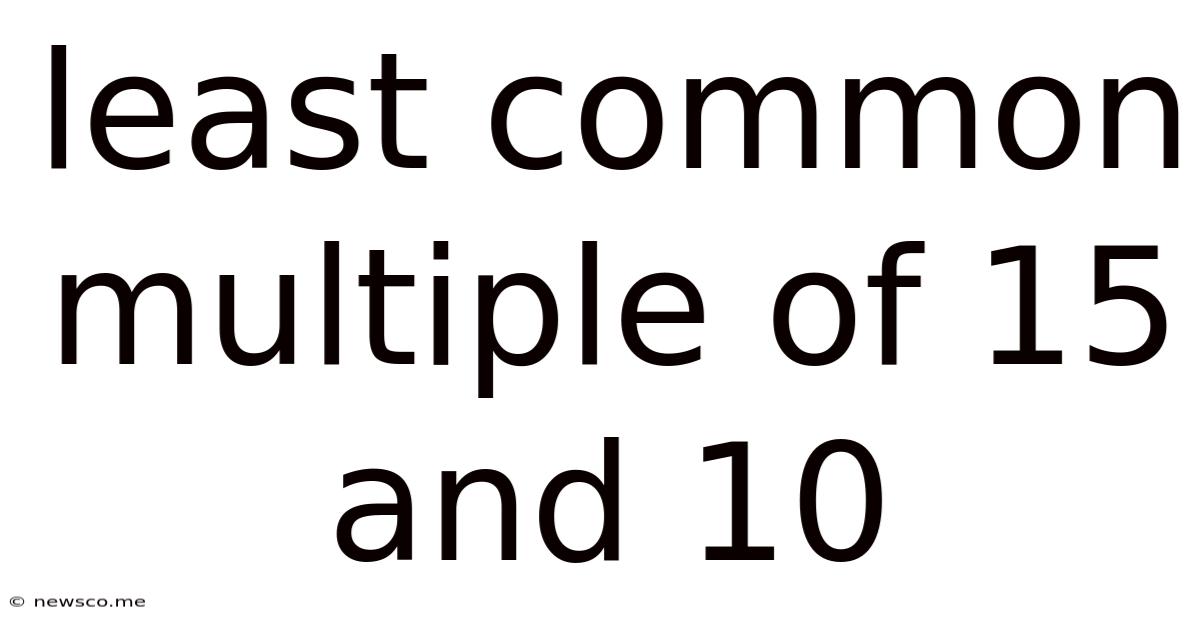Least Common Multiple Of 15 And 10
News Co
Mar 14, 2025 · 5 min read

Table of Contents
Finding the Least Common Multiple (LCM) of 15 and 10: A Comprehensive Guide
The least common multiple (LCM) is a fundamental concept in mathematics, particularly in number theory and arithmetic. Understanding LCMs is crucial for solving various problems, from simplifying fractions to scheduling events. This comprehensive guide delves into the methods for finding the LCM of 15 and 10, explaining the underlying principles and offering various approaches to solve similar problems. We’ll explore both manual calculation techniques and the application of helpful tools and concepts.
Understanding Least Common Multiple (LCM)
Before diving into the specifics of finding the LCM of 15 and 10, let's solidify our understanding of what LCM actually means. The least common multiple of two or more integers is the smallest positive integer that is a multiple of all the integers. In simpler terms, it's the smallest number that can be divided evenly by all the given numbers without leaving a remainder.
For example, consider the numbers 2 and 3. The multiples of 2 are 2, 4, 6, 8, 10, 12, and so on. The multiples of 3 are 3, 6, 9, 12, 15, and so on. The smallest number that appears in both lists is 6. Therefore, the LCM of 2 and 3 is 6.
Methods for Finding the LCM of 15 and 10
There are several effective ways to determine the LCM of 15 and 10. We'll explore the most common and straightforward methods:
1. Listing Multiples Method
This is the most intuitive method, especially for smaller numbers. We list the multiples of each number until we find the smallest common multiple.
- Multiples of 10: 10, 20, 30, 40, 50, 60...
- Multiples of 15: 15, 30, 45, 60, 75...
The smallest number that appears in both lists is 30. Therefore, the LCM of 15 and 10 is 30.
This method is simple for smaller numbers, but it can become cumbersome and time-consuming for larger numbers.
2. Prime Factorization Method
This method is more efficient for larger numbers and provides a more systematic approach. It involves finding the prime factorization of each number and then constructing the LCM using the highest powers of each prime factor present in the factorizations.
- Prime factorization of 10: 2 x 5
- Prime factorization of 15: 3 x 5
To find the LCM, we take the highest power of each prime factor present in either factorization:
- The highest power of 2 is 2¹ = 2
- The highest power of 3 is 3¹ = 3
- The highest power of 5 is 5¹ = 5
Multiplying these together: 2 x 3 x 5 = 30. Therefore, the LCM of 15 and 10 is 30.
3. Greatest Common Divisor (GCD) Method
This method uses the relationship between the LCM and the greatest common divisor (GCD) of two numbers. The GCD is the largest number that divides both numbers without leaving a remainder. The formula relating LCM and GCD is:
LCM(a, b) x GCD(a, b) = a x b
First, let's find the GCD of 15 and 10 using the Euclidean algorithm:
- Divide the larger number (15) by the smaller number (10): 15 ÷ 10 = 1 with a remainder of 5.
- Replace the larger number with the smaller number (10) and the smaller number with the remainder (5): 10 ÷ 5 = 2 with a remainder of 0.
- The GCD is the last non-zero remainder, which is 5.
Now, we can use the formula:
LCM(15, 10) x GCD(15, 10) = 15 x 10 LCM(15, 10) x 5 = 150 LCM(15, 10) = 150 ÷ 5 = 30
Therefore, the LCM of 15 and 10 is 30.
Applications of LCM
Understanding and calculating LCMs has numerous practical applications across various fields:
-
Fraction Addition and Subtraction: Finding a common denominator when adding or subtracting fractions requires finding the LCM of the denominators.
-
Scheduling and Timing: Determining when events will occur simultaneously, such as the meeting of two buses at a bus stop or the alignment of gears in machinery, often involves calculating LCMs.
-
Project Management: In project scheduling, the LCM can help determine the optimal time intervals for various tasks or phases of a project.
-
Music Theory: Finding the least common multiple of the note durations helps in determining the rhythmic structure and harmony in music composition.
LCM for More Than Two Numbers
The methods discussed above can be extended to find the LCM of more than two numbers. For the prime factorization method, you simply include all prime factors from all the numbers, taking the highest power of each. For the GCD method, you would need to iteratively find the LCM of pairs of numbers.
Conclusion: Mastering LCM Calculations
Calculating the least common multiple is a fundamental skill with wide-ranging applications. While the listing multiples method is simple for small numbers, the prime factorization and GCD methods provide more efficient and systematic approaches for larger numbers and more complex problems. Understanding these methods empowers you to tackle various mathematical and real-world challenges effectively. Practice is key to mastering LCM calculations and applying this valuable concept in diverse contexts. Remember to choose the method that best suits the numbers involved and your comfort level with different mathematical techniques. The understanding of LCM is not only crucial for academic success but also for problem-solving in various practical scenarios. By mastering LCM calculations, you significantly enhance your mathematical aptitude and problem-solving capabilities.
Latest Posts
Related Post
Thank you for visiting our website which covers about Least Common Multiple Of 15 And 10 . We hope the information provided has been useful to you. Feel free to contact us if you have any questions or need further assistance. See you next time and don't miss to bookmark.